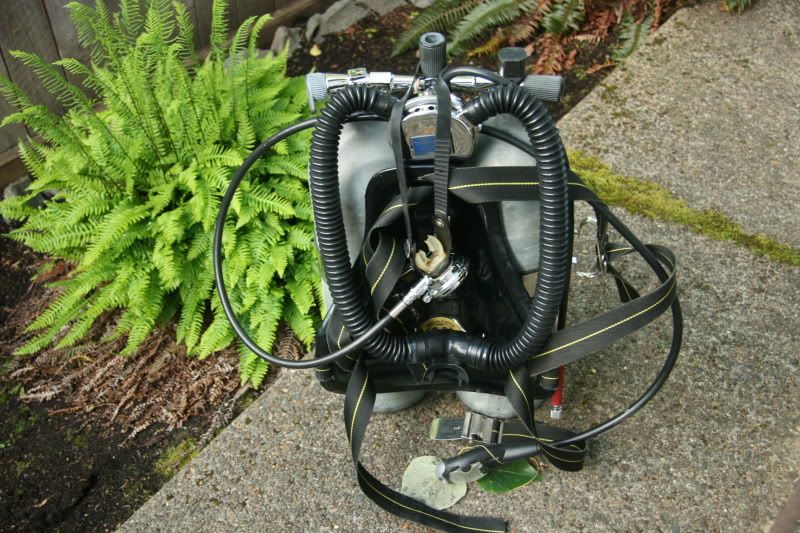I'll add a few more things. There was a regulator that USD put out called the New Mistral which incorporated all the LP and HP ports with a double hose which was attached to the first stage of an already-produced regulator (the Titan, I think). It has also been discontinued, but some may have it. Also, I have a different adaptation for the Aquamaste, called the Mossback Mk III, which incorporates an entire new first stage, along with LP and HP ports. Its production has been suspended due to the economy, but may come back in its current form or a newer version later. Here is a photo of it:
A few potential "gotcha's" that no one has thought about.
First, for surface swimming it is difficult to swim on your back because of the free flow of the double hose regulator. So either planning the dive without surface swimming, or having a snorkel, is necessary. An alternative is to turn off the air for the surface swim, but then there is a potential for getting water into the regulator's boxes too.
Second, to clear the regulator you need to put the non-return in the left side of the mouthpiece down. Then to get the water out of the hose (which with non-returns in the mouthpiece is not completely necessary), it is best to roll to the left while exhaling. This is what the Captain wanted you to read about above.
To make the conversion to a Phoenix Royal Aquamaster (PRA), you need first to have either a Royal Aquamaster or a DA Aquamaster. The conversion is simply for the first stage of that regulator. Which brings up the next "Gotcha." Someone may get "hooked" on double hose diving, and not easily find an Aquamaster to convert. There are currently a couple on EBay to buy, and this is what you want:
US DIVERS AQUA-MASTER DOUBLE HOSE VINTAGE REGULATOR | eBay
There is another, but you probably don't want to try bidding for it as it is a US Navy Anti-magnetic Aquamaster, very collectible and one you do not want to convert to a PRA.
Aqua-Lung DA-Aquamaster Vintage Double Hose Regulator | eBay
It has a beginning bidding price on it, and will probably sell for over $1000 as its interior parts are all gold-plated. With the price of gold lately, I think this will easily top the one-grand mark.
If they are not hooked now, get them a
SeawiscopeEY along with the double hose regulator. The regulator will allow very close observation of small fish and invertebrates, and the SeawiscopeEY will allow you to see them close-up. I have met the optomitrist who invented this remarkable device, and would highly recommend it to anyone who is interested in close-up observation of marine life. It is also great for fellows like me who are getting older, and need an optical device with which to observe gauges and watches. Here is a
You Tube Video of the Seawiscope; think of it with a double hose regulator and bubbles behind you!
Good luck, and tell us how your Japanese clientele enjoys the double hose.
SeaRat





